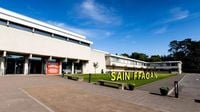In the early hours of Monday, October 6, 2025, a brazen and meticulously planned burglary shook St Fagans National Museum of History in Cardiff, one of Wales’s most cherished cultural institutions. According to South Wales Police, two suspects forced their way into the main building at around 12:30am, targeting a display case in the museum’s renowned ‘Wales is’ gallery. Their prize? Several pieces of Bronze Age gold jewellery—artefacts whose historical and cultural significance is hard to overstate.
Detective Inspector Bob Chambers, who is leading the investigation for South Wales Police, described the break-in as a “targeted attack.” He explained, “At this time, we believe that two suspects forced entry to the main building, where several items, including Bronze Age gold jewellery, have been stolen from a display case. An investigation is on-going, and we urge anyone with information to contact us as soon as possible. Any information, no matter how small, may be relevant to the investigation.” Chambers’s words, reported by BBC and echoed by multiple outlets, underscore the urgency and seriousness with which authorities are treating the incident.
The museum itself, operated by Amgueddfa Cymru/Museum Wales, expressed deep sorrow over the theft. In a statement, a spokesperson said, “As a museum we are saddened by the events in what was a targeted attack on St Fagans National Museum of History in Cardiff. The objects presumed stolen are examples of Bronze Age gold jewellery and were on display in the ‘Wales is’ gallery.” The spokesperson added gratitude for the swift response from South Wales Police and highlighted that, thankfully, staff members on duty overnight followed protocol and were uninjured during the incident.
While police and museum officials have not yet disclosed a full inventory of the stolen items, reports from The Guardian and other sources note that the ‘Wales is’ gallery has displayed significant artefacts, including bracelets and a lunala—a distinctive crescent-shaped piece of jewellery typical of the Bronze Age. These treasures, dating from a period spanning roughly 2300 BC to 800 BC, offer rare glimpses into the craftsmanship, culture, and social hierarchies of prehistoric Wales.
Founded in 1948 and redeveloped in 2018 with new galleries dedicated to social history and archaeology, St Fagans is more than just a museum. Its grounds, which include the late 16th-century St Fagans Castle, host over 50 recreated historic buildings from across Wales—ranging from a medieval church and a Victorian school to a workmen’s institute and, most recently, the Vulcan Hotel, a Cardiff pub painstakingly relocated brick by brick. The museum’s mission is to bring Welsh history alive for visitors of all ages, and it serves as a vital resource for both locals and tourists.
The timing of the burglary could hardly have been worse. The museum was set to host the Museums Association’s annual conference that week, drawing hundreds of delegates from across the UK. Despite the shock and disruption of the theft, the conference proceeded as planned. The Museums Association released a statement expressing solidarity: “We know this is a much-loved institution in Wales and internationally, and we hope that items can be recovered as soon as possible. Delegates to our annual conference are very much looking forward to exploring the site and meeting hundreds of attendees from across the UK, and we have been working hard with colleagues at Amgueddfa Cymru to make sure that everything is running smoothly and will be ready to welcome everyone onto the site for the conference.”
As the investigation unfolds, the museum has been closed to the public, officially citing storm damage as the reason on its website. This closure, while necessary, has only heightened the sense of loss and disruption. Scheduled events, including a family day celebrating Somali heritage and Christmas carols in the chapel, are now in limbo, leaving staff and the wider community to grapple with the impact of the crime.
St Fagans is not alone in facing such challenges. The theft comes on the heels of a similar burglary at the Royal Albert Memorial Museum and Art Gallery in Exeter, where, in September 2025, two suspects stole 17 antique pocket watches dating from the late 18th century and an early 19th-century blunderbuss. Devon and Cornwall Police reported that the suspects, believed to be men dressed in black and riding bicycles, made off with watches crafted by famed horologist Charles Frodsham and others. The back-to-back incidents have raised alarms about the security of Britain’s cultural heritage, especially as museums strive to balance public access with the need to protect irreplaceable artefacts.
In Cardiff, the response from the local community and the broader museum sector has been swift and supportive. The Glamorgan Star, the largest newspaper in the Vale of Glamorgan, has urged readers to assist the investigation, providing contact details for South Wales Police and Crimestoppers. Anyone with information is asked to quote reference 2500319252 when reaching out to authorities, whether via live chat, telephone, or anonymously through Crimestoppers.
For many, the loss is deeply personal. St Fagans is woven into the fabric of Welsh life, a place where generations have come to learn about their country’s past. The stolen jewellery represented not just ancient craftsmanship but also a tangible link to the people who lived, worked, and dreamed in Wales thousands of years ago. As the museum spokesperson put it, “We are also very grateful to the staff members who were on duty overnight, followed protocol and who were thankfully uninjured during the incident.”
The investigation remains ongoing, with police following up on all leads and reviewing security footage. For now, the hope is that the stolen artefacts can be recovered and returned to their rightful place, where they can continue to inspire wonder and curiosity in future generations. In the meantime, the incident serves as a stark reminder of the vulnerability of our shared heritage—and the importance of vigilance in protecting it.
As the days pass, the staff at St Fagans, the wider museum community, and the people of Wales wait anxiously for news. The story of the stolen Bronze Age treasures is still unfolding, but the determination to see justice done and history preserved is stronger than ever.


